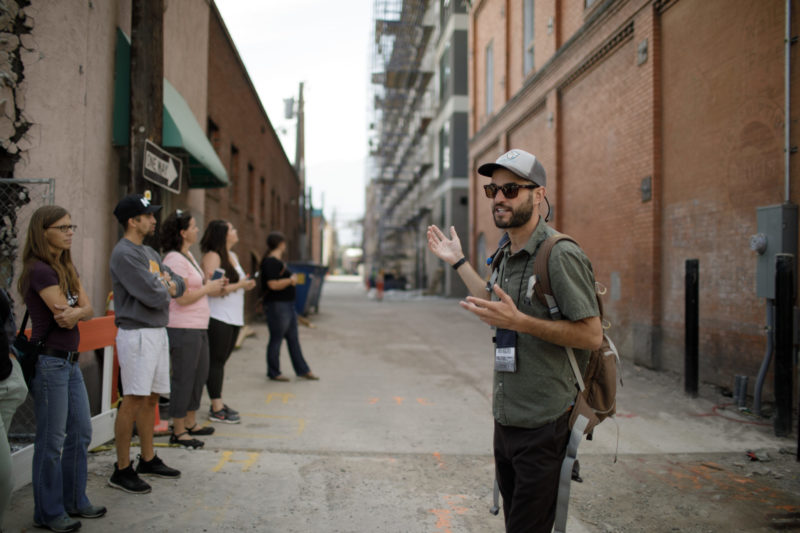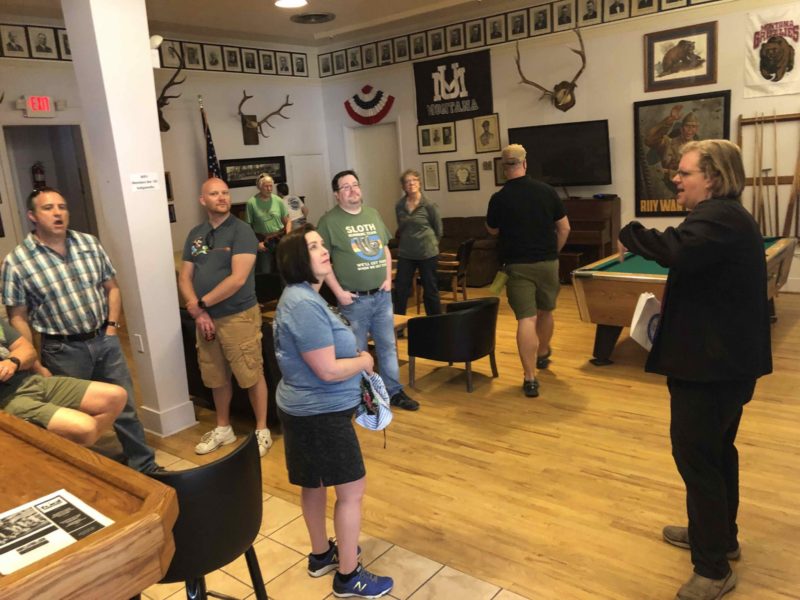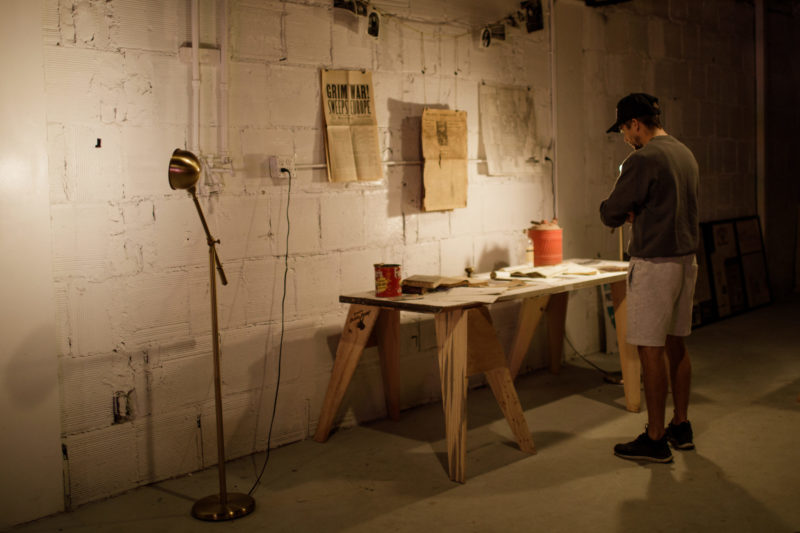Public history students and city history tours: A collaboration
20 June 2019 – Rachel Gross

1. Jon Sand guides an “Unseen Missoula” tour group through an alleyway. Photo credit: Athena Photography.
Every week throughout the summer, small groups of residents of Missoula, Montana, meet at Caras Park near downtown for history tours called “Unseen Missoula.” One important contributor to the development of the tour program has been the public history students of the University of Montana. Many of the stories tour-goers encounter on the two-hour excursion through the city center are the result of a public history course at UM offered in fall 2018 that included an assignment for developing new tour content. Although there were challenges of integrating student work into existing tours, UM students’ participation brought benefits both for the tour and for students’ professional development.
The first day of the fall semester, graduate and undergraduate students enrolled in Public History met not in a classroom, but downtown, at the starting point for the city’s Unseen Missoula tours. On the first day of class, students took the tour, took notes on the content and presentation, and then discussed their reactions and critiques with the tour guide and one member of the tour’s advisory committee. The course assignment was to revise the existing tours to incorporate new historical content and interpretation in order to diversify the stories the tour tells. Ultimately, I hoped that the class would produce a script that Unseen Missoula tour guides could use to present new stories to a broad audience in 2019.
I joined Unseen Missoula as a tour guide when the program was just beginning in June of 2018 with the goal of developing an assignment for my public history students. I noticed two challenges with the tours in the early months. First, the advisory committee that created the tours had historical expertise and done heavy lifting upfront, but the program lacked the structure for the ongoing editing of content. Second, good publicity meant the tours were immediately popular and tickets were sold out months in advance. This public interest was gratifying, but we spent more time training new tour guides than adding to the tour script.

Tour guide Charley Macorn leads visitors through the Elks Lodge. Photo credit: Rachel Gross.
For the fall 2018 semester, I had grand ambitions of writing a completely new script with this student research, but I scaled back the assignment to a more reasonable request that students contribute a new character, building, or topic to the existing script. The scaffolded assignments were all short—less than one page—and designed to get students regular feedback and a chance to present their research publicly. The assignments I developed were a tour review, a tour expansion proposal, a tour transcript draft and revision, and a public presentation of research to tour committee representatives.
Students added new content with careful attention to diversifying stories. The bulk of the original tour revolved around wealthy, white businessmen, and for good reason: there were excellent historical sources available on men like A.B. Hammond (1848-1934) and the buildings he had owned. However, students decided in our initial class meeting that the tour could better reflect Missoula’s complex history. For instance, tour guides already mentioned Mary Gleim (1849-1914), known for owning “female boarding houses” in the city’s red-light district at the turn of the twentieth century. The student who researched Gleim added her legal business ventures to the list of extra-legal ones tour guides already mentioned, effectively comparing Gleim to historical figures like Hammond. Another addition helped complicate the story of “Free Speech Corner,” where, in 1909, Industrial Workers of the World organizer Elizabeth Gurley Flynn (1890-1964) planned a direct action that helped sparked the labor movement’s fight for free speech through the West. A couple of students, in search of more on Missoula’s Chinese residents in the nineteenth century, instead found a trend of twentieth-century white residents who sensationalized that history. Though there is little trace of Missoula’s Chinese past at street level, local papers in the 1970s through the 1990s covered the search for remnants of opium dens and underground tunnels.

A pop-up museum in the basement of Missoula’s Hammond Building allows tour-goers to see historic artifacts up close. Image Photo credit: Athena Photography.
Not all content the students developed was added to the tours, however. While the story of an indigenous person whom white Missoulians lynched in 1878 evoked the legacy of colonial violence, the student did not link the story to a particular location, so it was not clear to those revising the tour how to make use of the story. Others told interesting stories about downtown buildings that were simply too far from the established tour route. The student projects that were eventually integrated into the new script were usually ones that carefully adhered to my suggestions as an instructor—as a tour guide familiar with what would be feasible for the tour. While the Unseen Missoula committee—consisting of local history professionals as well as city officials—meets regularly, a student intern is ultimately tasked with making tour revisions.
The most important part of the work process that allowed student work to be of use to the city’s tour committee was the sharing of digital files. Students uploaded their final tour script additions to a shared folder online. Getting the tour material integrated into the new script took months of follow-up and my continued involvement as a tour guide. The city was eager to have the student work, but there was no consistent method for keeping track of the projects. Ultimately, my direct connection with Unseen Missoula as a tour guide and the relationships I built with committee members and city employees were what made the students’ assignments successful beyond the classroom.
The tour assignment had a positive impact on students’ professional trajectories. One student applied for a job at a history consulting firm after hearing about the work that an Unseen Missoula committee member did. Another applied to be the city’s intern, and now currently works on making the very tour revisions that he and his classmates proposed. The graduate students working on the project are eager to pursue careers in public history, in part because the course assignments allowed them to see how their skills might have a direct impact on local projects. The undergraduates likewise learned the value of venturing into the community to see how to make use of their academic training.
The Unseen Missoula tour program has benefited from this work as well. Throughout 2019, hundreds of visitors will learn to ask new questions about Missoula’s past. For these tour-goers, the stories of Mary Gleim and the city’s IWW activists—stories developed by UM students—will be central to the history they learn.
~ Rachel Gross is a postdoctoral Teaching, Research, and Mentoring Fellow at the Davidson Honors College of the University of Montana. In 2020 she will be an assistant professor of history at the University of Colorado Denver.



